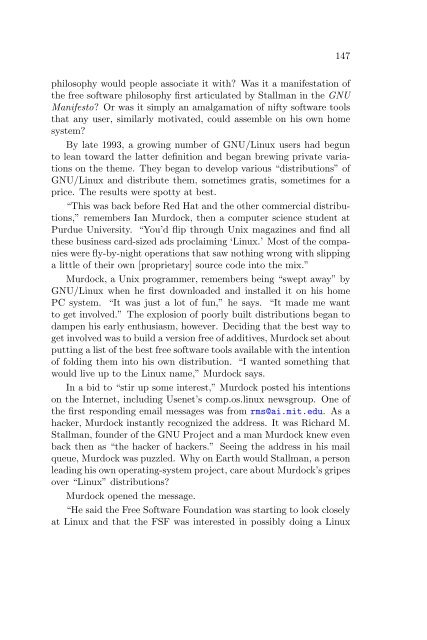Create successful ePaper yourself
Turn your PDF publications into a flip-book with our unique Google optimized e-Paper software.
147<br />
philosophy would people associate it with? Was it a manifestation of<br />
the free software philosophy first articulated by Stallman in the GNU<br />
Manifesto? Or was it simply an amalgamation of nifty software tools<br />
that any user, similarly motivated, could assemble on his own home<br />
system?<br />
By late 1993, a growing number of GNU/Linux users had begun<br />
to lean toward the latter definition and began brewing private variations<br />
on the theme. They began to develop various “distributions” of<br />
GNU/Linux and distribute them, sometimes gratis, sometimes for a<br />
price. The results were spotty at best.<br />
“This was back before Red Hat and the other commercial distributions,”<br />
remembers Ian Murdock, then a computer science student at<br />
Purdue University. “You’d flip through Unix magazines and find all<br />
these business card-sized ads proclaiming ‘Linux.’ Most of the companies<br />
were fly-by-night operations that saw nothing wrong with slipping<br />
a little of their own [proprietary] source code into the mix.”<br />
Murdock, a Unix programmer, remembers being “swept away” by<br />
GNU/Linux when he first downloaded and installed it on his home<br />
PC system. “It was just a lot of fun,” he says. “It made me want<br />
to get involved.” The explosion of poorly built distributions began to<br />
dampen his early enthusiasm, however. Deciding that the best way to<br />
get involved was to build a version free of additives, Murdock set about<br />
putting a list of the best free software tools available with the intention<br />
of folding them into his own distribution. “I wanted something that<br />
would live up to the Linux name,” Murdock says.<br />
In a bid to “stir up some interest,” Murdock posted his intentions<br />
on the Internet, including Usenet’s comp.os.linux newsgroup. One of<br />
the first responding email messages was from rms@ai.mit.edu. As a<br />
hacker, Murdock instantly recognized the address. It was Richard M.<br />
Stallman, founder of the GNU Project and a man Murdock knew even<br />
back then as “the hacker of hackers.” Seeing the address in his mail<br />
queue, Murdock was puzzled. Why on Earth would Stallman, a person<br />
leading his own operating-system project, care about Murdock’s gripes<br />
over “Linux” distributions?<br />
Murdock opened the message.<br />
“He said the Free Software Foundation was starting to look closely<br />
at Linux and that the FSF was interested in possibly doing a Linux


